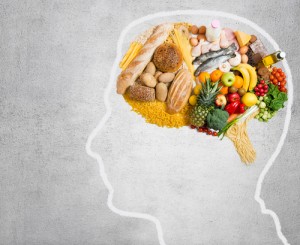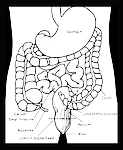Know yourself
 The second step is about knowing yourself in order to find the diet that provides optimum nutrition for yourself. This involves personalising your diet with the help of nutritional coaching.
The second step is about knowing yourself in order to find the diet that provides optimum nutrition for yourself. This involves personalising your diet with the help of nutritional coaching. Our best doctor is ourselves.
Dr. Natasha Campbell-McBride states: "There is no universal rule, and anyone who tries to prescribe us when we should fast and when we should eat should not be listened to. No scientist, no doctor in the world and no laboratory can tell you what you should do personally. The only authority that everyone should listen to is his own body, because Mother Nature has taken billions of years to draw it.”
Our body knows exactly what is best for it; we only need to listen to our body. Every animal knows instinctively what to eat. Why are we humans the only ones who don't know what is best for us? Why do we consume food that is harmful to us? What factors prevent us from listening to our bodies?
We need to start getting to know ourselves in order to take our health into our own hands.
As the titles of Michel Dogna’s books state: “Prenez en main votre santé” (take your health into your own hands); each person has to take charge of their own health. Doctors and therapists are there to help and advise, but fear shouldn’t motivate a person to blindly obey them. The stress caused by the diagnosis or judgement of a doctor or therapist may prevent recovery. Instead, the health practitioner should communicate hope to the patient, with an air of humility, as they are faced with the extraordinary perfection and complexity of the human body. In addition, the patient needs positive energy, encouragement, and support.
In the case of drinking alcohol, it can be very difficult for a therapist or a doctor to make the link between the consumption of alcohol and the migraine unless the patient is asked about his lifestyle and dietary habits. But it is not difficult for the patient to realise that the first time he drank alcohol was followed by his experience of the headache. He is not to blame; we have been taught from childhood that only doctors know about our health, and that we must blindly believe them. We have been taught that we do no know how to heal ourselves, and of course, that it lies beyond our ability to find the cause of our health problems.
Recovering our connection with our body
If we are to experience optimum health, we must listen to our bodies – but we are disconnected from our body for various reasons:
 1.- Our mind. Our mind is more powerful than our body; it can control or disable any physical need. This is one of the features that differentiates us from animals. Mentally balanced people can control their physiological needs, sex drive, violent impulses, and of course, their hunger. However, our ability to control our hunger may come at a high price – it could result in dulled instincts about which foods are beneficial for us. We may end up holding back on our physiological needs, which may result in constipation; or we could end up drinking excessive or insufficient amounts of fluid..
1.- Our mind. Our mind is more powerful than our body; it can control or disable any physical need. This is one of the features that differentiates us from animals. Mentally balanced people can control their physiological needs, sex drive, violent impulses, and of course, their hunger. However, our ability to control our hunger may come at a high price – it could result in dulled instincts about which foods are beneficial for us. We may end up holding back on our physiological needs, which may result in constipation; or we could end up drinking excessive or insufficient amounts of fluid..2.- Our beliefs. From an early age we are instilled with beliefs about what is beneficial and what is harmful. We receive input from many different sources: school teachers, parents, television programmes and advertising, religion, culture, friends, doctors, and nowadays the internet too. It is our minds – and our belief systems too – that elevate us as humans. Yet we are disconnected from our physical needs. We no longer listen to our bodies – instead we listen to doctors, nutritionists, friends, family members, the doctrines of faith, etc.
For instance, a Buddhist person may follow a macrobiotic diet without questioning if such a high intake of grains is really good for him. Another person may have a diet high in dairy products because he was taught that such a diet provides calcium for his bones – yet he may have a lactose intolerance.
It's important to question each item of dietary dogma. Dr. David Katz gives wise advice: "Don’t just read opinions that confirm your own. If all you read is the stuff that agrees with what you want to believe in the first place, you’re taking a biased approach and not likely to wind up with a balanced perspective. You’ve got to read the best stuff that disagrees with what you’re hoping is true. Then, if you can still believe what you wanted to believe, it may be robust."
But, can we really trust our bodies’ messages? We need to be aware that our bodies can mislead us if we confuse what the body needs with the body’s “caprices” . There are many kinds of situations that can cause our body to send wrong signals, for instance:
1.- Food addiction, e.g. sugar. The intake of the addictive substance produces these pleasure hormones: endorphins, serotonin, dopamine and oxytocin. One theory states that the cells protect themselves from the excess of these pleasurable substances by reducing the receptors, that is, by developing a resistance to them. The person must then increase the intake of the addictive product in order to get the same effect. This is how addictions start. Another theory argues that, over time, the brain loses its ability to produce its own neurotransmitters and depends on addictive products to obtain them. The same process happens with alcohol.
2.- An excessive development of undesirable or pathogenic bacteria in the gut can take us hostage by producing certain neurotoxins that activate the receptors of well-being. This happens, for example, in the case of a yeast infection such as Candida, which produces these pleasurable substances when they are fed with sugar or carbohydrates. It is not easy to cut down on sugar and carbs when there is a yeast infection. But as mentioned above, our mind is far more powerful than our body, so it is possible to achieve the goal! Many people have done so, even though it is hard.
3.- There is an enzymatic failure which prevents proper digestion of certain foods, such as gluten and casein. In this case, these proteins become opioid peptides. If there is also a leaky gut and a leaky brain, then the opioid peptides can alter the neurotransmitters of the brain, acting like opium, and causing an addiction. This situation can even lead to certain psychological and neurological diseases.
In all these cases, an external control of the body is necessary: choosing a diet and sticking to it either through our own conscious determination or with the help of another person – perhaps a family member or a close friend. Sometimes a short stay in a health clinic or resort is recommended.
There are also many different therapies that geared to dealing with addictions. In the third principle of Living Fully Nourished - Coaching - we suggest some of these therapies.
When the mind has opted for an incorrect diet, it takes hard work to put into doubt and get rid of all preconceived ideas about nutrition.. How can this be achieved?
One very useful tool that can be used to reconnect with our bodies is meditation and conscious eating.
Mindful eating
To begin with, you need to relax before eating. Disconnect from surrounding distractions: work, news on the TV, phone, social media, friends, colleagues, or family. Conscious eating means eating alone for a few days, almost in a state of meditation. In order to do this:
1.- Perform some breathing exercises to relax before eating. You can even do a little bit of meditation.
2.- Focus on the sensations of the body before, during, and after the meal. Ask yourself the following question: Am I really hungry? Analyse the signs that the body is giving you that indicate that you are hungry: are you genuinely hungry or are you going to eat simply because it's meal time. In the chapter on Food we will explain in more detail how to differentiate true hunger from mere appetite.
3.- Prepare your own meal. Cooking our own food engages all the senses and helps stimulate the digestive system. Also, if done consciously, with positive thoughts, and if prepared with love, the food becomes rich vitamin L – love.
4.- If you are a believer, or simply recognize the power of the mind, giving thanks for the meal you are going to enjoy and blessing it increases the meal’s positive energy, or the levels of vitamin L.
 5.- Eat consciously: taste the food, focus on the smell, texture, presentation (colour, shape), taste, and temperature. Chew slowly. Be aware, so that you notice when you are full and stop eating at that moment. If there is still some food on your plate, just store it in the fridge – there is no need to eat it all at once.
5.- Eat consciously: taste the food, focus on the smell, texture, presentation (colour, shape), taste, and temperature. Chew slowly. Be aware, so that you notice when you are full and stop eating at that moment. If there is still some food on your plate, just store it in the fridge – there is no need to eat it all at once.6.- Again, give thanks for the food that has been eaten, and thank the chef. You may visualize how food is digested properly (for example, imagine scissors cutting food up to its basic elements), and how these basic elements are then distributed throughout the body, transported by the blood to nourish all the cells of your body.
7.- The most important part is to pay attention to the reactions of your body after eating: do you feel satisfied or are you starting to experience gases, pain, or rumblings in the belly? Do you feel drowsy? Be aware of all the possible symptoms (pain anywhere in the body, rashes, heart rate, mental activity, etc.), both immediately after eating and a few hours later. Should any symptoms occur at any moment of the day, write down everything that you have eaten in the past 48 hours.
You should perform this exercise for some time until you are able to eat consciously without much concentration in the company of others.
Once you have reconnected with your body, and you are ready to free yourself from preconceived ideas and try new styles of eating with an open mind and receptive body, you can start the process of distinguishing which foods benefit or harm you.
Ask yourself
In order to know which food is good for you, it would be useful to question all your dietary habits and beliefs. Consider reflecting about the following questions:
- “Are <grains> good for me?”
- “What amount of <grains> can my body tolerate, if any?”
- “What time of the day is best for me to eat <grains>, if any?”
- “How many times a week is good for me to eat <grains>, if any?”
- “Is this food combination (for instance: <chicken> with <rice>) good for me?”
- “Do I drink the right amount of <water>?”
Imagine that you are a detective on a quest to find out who is guilty of causing your diseases.
Testing different diets
 At this point you may investigate and interrogate all types of diets: vegetarian, high-protein diet, paleo diet, macrobiotic diet, raw food, etc. There are valid arguments in favour them all; how else would you conclude which one is the best for you? In addition, within each type of diet, there are as many variants as there are nutritionists on this planet.
At this point you may investigate and interrogate all types of diets: vegetarian, high-protein diet, paleo diet, macrobiotic diet, raw food, etc. There are valid arguments in favour them all; how else would you conclude which one is the best for you? In addition, within each type of diet, there are as many variants as there are nutritionists on this planet.One suggestion is to simply try a particular diet for a while. If that style of nutrition improves your physical and mental health, it indicates that it is probably a good diet for you. If it gets worse, it may be a detoxification reaction – a temporary worsening before improving – which happens in numerous therapies. It is necessary, therefore, to test a diet for a while. Typically, if the worsened condition is temporary, then it is probably a detoxification reaction, while an extended period indicates that the diet is not suitable for you.
However, just because something makes you feel good (at first), this does not mean it is beneficial for your health. It is possible that the feeling of well-being comes from food that has a stimulatory effect, while, in reality, it depletes the vital energy. Alcohol and coffee fall into this category.
It is not an encouraging sign if a person doesn’t notice any difference with a change of diet; there should be some change in symptoms. The nature of the symptoms will determine how long it should take for an effect to be noticed. Gastroenterological symptoms take quite a short time to manifest – two weeks maximum, usually much shorter. But neurological diseases, cardiovascular diseases, and chronic diseases in general may only show improvement over a long period of time – months, even years.
Intolerances and nutritional needs change over the course of a lifetime. A person does not have the same needs in childhood, adolescence, adulthood, or in old age. Babies have all their nutritional needs covered by breast milk, but this is clearly not the case for children or adults. Children typically exhibit more food allergies and intolerances, because the body has more energy to react against offending food. Old age needs a lesser intake of energy coming from food.
You are your best doctor. The best doctors for children are their parents. The perfect way to ensure your family’s healthy is to study nutrition yourself, so that you can decide which foods are optimal for you and your children. But it takes a lot of time and effort to really understand all the nutritional approaches, and to experiment with each one of them. A nutritionist can help with this process. They can quickly eliminate unhelpful options and direct you to the right path, saving you time and effort. This being said, you will always have the final say as to what is best for you and your family.
Unhealthy food and food intolerance
The line between unhealthy food and food that causes intolerant reactions is very blurred. There are certain foods which virtually all nutritionists describe as unhealthy. But most food is harder to classify definitively: what is regarded as healthy by certain nutritionists can be regarded as unhealthy for others.
Foods that are unanimously considered to be harmful are:
* Processed or industrial food: hydrogenated oils; additives: colourings, preservatives, anti-caking agents, thickeners, flavour enhancers (monosodium glutamate); artificial sweeteners: saccharin, aspartame, sorbitol, sucralose, acesulfame, neotame.
* Products that have been chemically treated with pesticides, antibiotics, hormones, or genetically modified products
 * Products that have been roasted or burnt at high temperatures: vegetable oils at high temperatures (fries and chips), barbecued meat, etc.
* Products that have been roasted or burnt at high temperatures: vegetable oils at high temperatures (fries and chips), barbecued meat, etc.Foods that are not unanimously considered harmful can be classified as food that either causes symptoms of intolerance, or not.
Strategies for identifying food intolerances
Almost every person who suffers from a disease of one sort or another, whether chronic or acute, is affected by food intolerance. In some cases, it is only is possible for healing to take place when the food responsible for the intolerance is removed.
The symptoms of various food intolerances are delayed, from a few hours to a few days. This is in contrast to an allergy, which causes an immediate reaction. It is for this reason that intolerances are so difficult to identify.
It is a huge task to test all foods to ascertain whether they are problematic or not. However, you can use different strategies to identify whether you have any kind of intolerance.
* Elimination and reintroduction diet
This consists of eliminating a certain food for a while and observing whether the symptoms disappear or not. Then we reintroduce the food and check if the symptoms reappear or worsen. If this is the case, it is fairly certain that this kind of food is not good for you.
The problem with this approach is that you need to have enough willpower to remove that food, especially considering that this very food can also create a dependency, with the consequent withdrawal symptoms.
The type of disease will usually determine how long you need to exclude a particular food from you diet before you start noticing results. For allergies, hypersensitivities, and digestive disorders the time is usually quite short – one or two weeks is usually enough. However, in the case of chronic inflammatory diseases a trial period of about three months is often required, while in the case of neurological diseases it may even be six months.
This method of food intolerance detection is particularly suitable for small children and babies; this way has the advantage of avoiding the use needles for medical tests.
Just as the exclusion period may extend for a while before any change is noticed, in the reintroduction phase it can happen that no symptoms are present at first, but after a few months of consuming the food again, the symptoms reappear. This happens because the antibodies decline very slowly during the elimination phase, and then gradually increase during the reintroduction phase. Consequently, until the antibodies reach the level at which symptoms manifest again, the intolerance goes unnoticed.
So ideally, you should embark on an elimination/reintroduction diet focusing on one food at a time, planning for a period of time that may extend from one week to six months, depending on the type of disease. This entails eliminating a food over a certain period of time, and then allowing for the same period of time for the reintroduction phase. The same process must be repeated with the next food.
As you can imagine, this process is often not feasible for chronic diseases, but it can be very useful for most hypersensitivities and gastro-intestinal disorders.
In these cases, the guidelines I recommend during the reintroduction phase are as follows:
1.- Start the reintroduction very slowly, with small amounts of food, for example, a teaspoon.
2.- Wait three days to see if there is any reaction. If there is no reaction, then gradually increase the quantity of food.
3.- When you have reached a normal amount of food, and there has not been any reaction yet, continue eating it but only once or twice a week. Take this precaution for at least three months.
4.- During that time, you can reintroduce another food in the same way.
5.- Avoid consuming two suspected foods on the same day; leave at least a two-day gap between two suspected foods.
6.- If there is a reaction, note which suspected food was the last to be eaten. Eliminate that food again to check if it was the cause of the reaction.
7.- When three months of reintroducing a food has passed, and no problems have arisen, you can increase the frequency of consuming the food, if desired. While increasing the frequency, continue to check for reactions over a period of time – one month, for example.
8.- Once you are sure that your body is tolerating the food without any problems, you can start to reintroduce a different food.
I strongly recommend that you keep a journal noting what you eat each day, taking care to also record the state of your symptoms. Each time the same symptom appears, check in your journal if the same kind of food was consumed 48 hours before each occurrence of that symptom.
The elimination phase may proceed at a different pace for each person: for some people it is best to start eliminating all suspected foods right from the start, for others it is better to slowly eliminate one food at a time. The reintroduction phase may go faster in some cases, especially if the number of foods eliminated is minimal, and the symptoms of disease are mild. If the associated diseases are serious and there are several intolerances, then a slower pace is recommended.
* Provocation diet
This strategy entails increasing the amount of the suspected food very slowly, while noting if there is a worsening of the symptoms. This may be dangerous in certain acute diseases, but it may be the only option if you are unable to remove foods from your diet in order to do the elimination/reintroduction test.
* Clinical tests for food intolerances
There are several tests to determine food intolerance: serum antibody tests for immune intolerances; breath tests for lactose, sucrose, and fructose; stool tests for the gut microbiome; urine tests for organic metabolites and opioid peptides from gluten and casein, etc.
The disadvantage of clinical tests is that it is difficult to identify all intolerances, as science is not advanced enough. Intolerances that cannot be determined by way of tests are called "food sensitivities". This means that the person is aware of a food intolerance of some kind, as he feels better when avoiding that food, but the tests reveal no immunological, bacteriological, or enzymatic reaction.
In most cases, tests can usually identify very strong intolerances – but it is still necessary to work at knowing yourself in determine the details of your optimal nutrition.
* Biofield therapies
There are a variety of energy therapies that geared to detect energy blockages to different foods: kinesiology, NAET, bio-resonance, etc. These methods are time-consuming, since only a few items of food can be tested in each session. Some intolerances may be found, but I believe that medical tests are more accurate, reliable, and faster too. A further difference is that energy therapies will often perform a treatment in the same session as the food testing in an attempt to heal this energy blockage.
My personal experience with biofield therapies is not very positive. Perhaps, this is because, like conventional medicine, such natural methods only “turn off” the alarm signals that the body sends in order to indicate a problem, while the real cause of the problem remains unaddressed. The advantage of these therapies is that they are non-invasive, which makes them an interesting option for children.
Once the food intolerances have been identified using any of the above methods (elimination/reintroduction, provocation, clinical tests, energy therapies), it is advisable to remove all these foods for at least a year in order to reduce antibodies to an acceptable level. IgG antibodies, which are responsible for most intolerances, increase and decrease their levels slowly.
Issues to consider when identifying food intolerances
* Bowel transit time
 The bowel transit time from ingestion of food until it reaches the anus may differ greatly depending on the type of food and how fast or slow the bowel transit of the person is. It takes much longer to digest meat than carbohydrates, and it takes longer to digest carbohydrates than fruit and vegetables. A meal containing vegetables, carbohydrates and proteins will normally take between 24 to 72 hours to be fully digested; for some people, especially women, it may take longer. The reaction to food may therefore take more than two days to show up, and in some cases it may take up to a week.
The bowel transit time from ingestion of food until it reaches the anus may differ greatly depending on the type of food and how fast or slow the bowel transit of the person is. It takes much longer to digest meat than carbohydrates, and it takes longer to digest carbohydrates than fruit and vegetables. A meal containing vegetables, carbohydrates and proteins will normally take between 24 to 72 hours to be fully digested; for some people, especially women, it may take longer. The reaction to food may therefore take more than two days to show up, and in some cases it may take up to a week.* Manifestation of intolerances
We are accustomed to associating gastro-intestinal troubles with food, but it’s less common to draw a connection between nutrition and chronic pain, fatigue, auto-immunity, respiratory allergies and asthma, problems with eyesight, bone-related issues, behavioural disorders, learning and cognitive disabilities (except for parents of autistic children), degenerative diseases, etc.
Our nutrition has an impact on every part of our body, but we often fail to recognise the immediate effects. A chronic disease may result from the regular intake of a food to which there is an intolerance; the cumulative effects of this food can lead to disease.
* Gravity of diseases
Diseases differ in the degree to which they pose a danger to the overall health of a person. Constipation is not as serious as asthma, and asthma in turn is not as life-threatening as a cancer.
Some foods can cause light gastro-intestinal discomfort, while others may lead to acute pain or to degenerative diseases.
Of course, it would be perfect if we could achieve optimal health, but this is not always possible. If this is the case, it is surely preferable to suffer a few small discomforts than to be debilitated by painful and dangerous chronic diseases.
For example, if person complains that fruits and vegetables make them feel bloated and gassy, they may be diagnosed as having a fructose intolerance, and could be advised to follow a FODMAP diet. This eating plan removes most fruits and vegetables from the person’s diet, with a consequent increase in the consumption of grain and animal products. This may relieve their intestinal issues, but new, worse health issues may appear, such as diseases of an inflammatory, cardiovascular, auto-immune, neurological, or degenerative nature.
We are accustomed to paying much attention to gastro-intestinal troubles, and that is all well and good; but it is even more important to prevent diseases that pose a greater threat to the person’s health and longevity.
* Intolerance to certain substances
Food intolerance can be caused by specific substances that are found in various foods. For instance, histamine, which can be found in fish, pork, all fermented products, chocolate, seafood, some fruit and vegetables, etc; or solanine, which is present in potato, tomato, bell pepper, and eggplant. In other instances, intolerance is specific to a certain variety of food, for example, red potatoes, or green beans.
It is possible to be intolerant of a certain type of cooking, for example, fried food, smoked food. Or to the dressing or basting sauce.
 Similarly, there may be an allergy to some of the materials used in the kitchen or to food packaging. These can include aluminium, which is present in some casseroles, aluminium foil, and in vaccines, as one of the adjuvants, or mercury, which is found in big fatty fish, vaccines, and amalgams, etc.
Similarly, there may be an allergy to some of the materials used in the kitchen or to food packaging. These can include aluminium, which is present in some casseroles, aluminium foil, and in vaccines, as one of the adjuvants, or mercury, which is found in big fatty fish, vaccines, and amalgams, etc.There are also some tests to determine a hypersensitivity or toxic reaction to some substances. However, finding the source could be quite a difficult task, since we are surrounded by toxics. Sometimes it seems that only solution is to move to a cottage in the countryside or on a mountain top, and to grow our own food.
* Quantity, frequency, and combination
The intensity of the diseases caused by some food intolerances often depend on the amount and frequency of that food eaten during the week.
Sometimes one kind of food could cause problems with the digestion of other food. Meat is incompatible with many other foods, mainly with carbohydrates and fruit. Eating fruit as a desert may be the cause of a fruit intolerance, while eating fruit on its own may be easily tolerated.
* Food addictions and intolerances
Typically, our bodies develop an addiction to foods to which we are intolerant. When a person begins to eliminate from his diet the food he is intolerant to, he may undergo a period of feeling worse at first. This may last from a few weeks to a few months, depending on the person. This is known as the withdrawal syndrome and die-off syndrome. These syndromes are explained by several theories:
- Some of the foods that cause food intolerance, mainly gluten and casein, create an addiction due to the fact that they produce opioid peptides that act like morphine or opium.
- Intolerance leads to inflammation, and the body releases endorphins in order to alleviate the pain. When the inflammation no longer exists, the production of endorphins stops, and the sense of well-being vanishes.
- By avoiding foods that cause intolerance – foods which were feeding undesirable gut bacteria – the bad bacteria die of starvation, releasing large amounts of toxins into the system, and causing a worsening of the symptoms. This is called the die-off reaction.
- Undesirable gut bacteria that live on foods that cause intolerances have effectively taken the person hostage: they send signals to the brain to encourage the person to continue eating those foods that nourish the bad bacteria. Going against these messages/commands requires a high level of conscious effort and will power.
As a rule, foods that do not produce the symptoms of intolerance have no significant effect on a person’s health when removed. For example, when we no longer eat some varieties of fruit or vegetables because they are out of season, we do not feel any improvement or worsening of our health. On the contrary, most people experience a significant impact on their health shortly after removing gluten, dairy products, sugar, coffee, chocolate, etc. from their diet.
* Hidden food intolerances
Some food intolerances may be caused by hidden intolerances to other food. For example, fructose (fruit) intolerance is usually due to a hidden intolerance to animal proteins. The long digestion time of flesh blocks the passage of fruits through the intestine. The fruit then ferments and gives off gas and toxins, causing bloating and other gastro-intestinal problems that are associated with fructose intolerance.
 Sometimes the cause of a problem with a certain food is not the food itself, but other circumstances. These can include over-eating, the way the food is prepared and cooked, the quality of the food, the oil, fat, or dressing used, or the pesticides or heavy metals contained in the food.
Sometimes the cause of a problem with a certain food is not the food itself, but other circumstances. These can include over-eating, the way the food is prepared and cooked, the quality of the food, the oil, fat, or dressing used, or the pesticides or heavy metals contained in the food.
Most of my patients complain that when avoiding gluten, they begin to have more gastro-intestinal problems, while other health problems such as pain, allergies, infections, etc. decrease significantly. The exact reason is unknown, but it is likely that by eliminating gluten the body "wakes up", stops being "drugged" and is better able to detect other harmful food. For example, sugars may start causing digestive problems – it could be that there was also a sucrose intolerance all along, but the person just didn’t realize it.
* Going from major to minor intolerances
It may take a person several years to complete a list of foods that cause food intolerance. The investigation starts with the main families – gluten, dairy, nuts, and eggs – and then we may begin to refine the details and investigate foods such as mushrooms, strawberries, etc.
Changing daily routines can help to uncover intolerances. Weekends, holiday periods, or trips can be used to see if the symptoms increase, decrease, or change in intensity. The change in daily routine may give clues to which things are the cause or origin of disease – things that we are exposed to on a daily basis, but that are absent from our environment or routine while on holiday.
* The evolution of food intolerances
Food intolerances evolve over time, especially if problems in the bowel are not resolved. This is what usually happens when replacing, for example, a gluten cereals with other gluten-free cereals. After consuming these cereals for some time an intolerance to these may also appear.
One possible explanation is that intolerances, especially ones that affect the immune system, appear due to leaky gut syndrome. This is a condition in which the gut is "leaky", allowing partially digested food proteins to pass through the intestine wall. These proteins are then identified as invaders and activate the body's defences. Consequently, we can become intolerant to a growing number of foods if the leaky gut is not repaired.
It is therefore necessary to first address the leaky gut syndrome before dealing with the intolerances. This is a very complex task, because leaky gut has many different causes: stress, gut flora dysbiosis, chemicals, medicines, etc.
My recommendation is to avoid the trap of replacing one food with another that is also known to cause food intolerance. Don’t replace wheat with corn, cow’s milk with goat’s milk, chicken eggs with quail eggs, almonds with other kind of nuts, etc.
A further measure for preventing the development of more food intolerances is to implement a four-day rotation cycle for different foods. This means that a particular food can be eaten only once every 4 days. This relates especially to the products we use in every meal, such as oils, spices, herbs, and various sauces, dressings and bastings.
When the level of IgG antibodies that respond to a certain food has normalized – a process that usually requires a year at least, the food may be reintroduced in order to verify if the intolerance has been resolved.
When reintroducing a food that caused an intolerant reaction, it must be noted that the body may take a while to generate enough antibodies to produce the symptoms of intolerance; days in some cases, weeks in others – and sometimes even months.
It is important to remember that a food intolerance is not reversed until the leaky gut is completely recovered.
In summary, in order to know yourself it is important to challenge your body, dare to make dietary changes, question all preconceived ideas, and try different diets.
Combining different strategies usually gives better results: performing the relevant tests, seeking the advice of a nutritional therapist, and embarking on an elimination/reintroduction diet.
 Gemma Calzada is a Holistic Health Ph.D. and a certified GAPS practitioner. Her mission is to improve health through nutrition and lifestyle.
Gemma Calzada is a Holistic Health Ph.D. and a certified GAPS practitioner. Her mission is to improve health through nutrition and lifestyle. 
